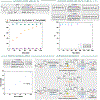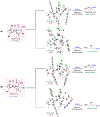Scope and Mechanistic Probe into Asymmetric Synthesis of α-Trisubstituted-α-Tertiary Amines by Rhodium Catalysis
- PMID: 37651695
- PMCID: PMC10581542
- DOI: 10.1021/jacs.3c04211
Scope and Mechanistic Probe into Asymmetric Synthesis of α-Trisubstituted-α-Tertiary Amines by Rhodium Catalysis
Abstract
Asymmetric reactions that convert racemic mixtures into enantioenriched amines are of significant importance due to the prevalence of amines in pharmaceuticals, with about 60% of drug candidates containing tertiary amines. Although transition-metal catalyzed allylic substitution processes have been developed to provide access to enantioenriched α-disubstituted allylic amines, enantioselective synthesis of sterically demanding α-tertiary amines with a tetrasubstituted carbon stereocenter remains a major challenge. Herein, we report a chiral diene-ligated rhodium-catalyzed asymmetric substitution of racemic tertiary allylic trichloroacetimidates with aliphatic secondary amines to afford α-trisubstituted-α-tertiary amines. Mechanistic investigation is conducted using synergistic experimental and computational studies. Density functional theory calculations show that the chiral diene-ligated rhodium promotes the ionization of tertiary allylic substrates to form both anti and syn π-allyl intermediates. The anti π-allyl pathway proceeds through a higher energy than the syn π-allyl pathway. The rate of conversion of the less reactive π-allyl intermediate to the more reactive isomer via π-σ-π interconversion was faster than the rate of nucleophilic attack onto the more reactive intermediate. These data imply that the Curtin-Hammett conditions are met in the amination reaction, leading to dynamic kinetic asymmetric transformation. Computational studies also show that hydrogen bonding interactions between β-oxygen of allylic substrate and amine-NH greatly assist the delivery of amine nucleophile onto more hindered internal carbon of the π-allyl intermediate. The synthetic utility of the current methodology is showcased by efficient preparation of α-trisubstituted-α-tertiary amines featuring pharmaceutically relevant secondary amine cores with good yields and excellent selectivities (branched-linear >99:1, up to 99% enantiomeric excess).
Conflict of interest statement
The authors declare no competing financial interest.
Figures











Similar articles
-
Rhodium-Catalyzed Asymmetric Synthesis of 1,2-Disubstituted Allylic Fluorides.Angew Chem Int Ed Engl. 2023 Nov 27;62(48):e202314843. doi: 10.1002/anie.202314843. Epub 2023 Oct 27. Angew Chem Int Ed Engl. 2023. PMID: 37856668 Free PMC article.
-
Chiral Amines via Enantioselective π-Allyliridium-C,O-Benzoate-Catalyzed Allylic Alkylation: Student Training via Industrial-Academic Collaboration.Acc Chem Res. 2022 Aug 2;55(15):2138-2147. doi: 10.1021/acs.accounts.2c00302. Epub 2022 Jul 13. Acc Chem Res. 2022. PMID: 35830564 Free PMC article.
-
Rhodium-catalyzed dynamic kinetic asymmetric transformations of racemic tertiary allylic trichloroacetimidates with anilines.J Am Chem Soc. 2012 May 23;134(20):8380-3. doi: 10.1021/ja302223p. Epub 2012 May 14. J Am Chem Soc. 2012. PMID: 22563701
-
Asymmetric Rhodium-Catalyzed Allylic Substitution Reactions: Discovery, Development and Applications to Target-Directed Synthesis.J Org Chem. 2018 Oct 5;83(19):11463-11479. doi: 10.1021/acs.joc.8b00583. Epub 2018 Sep 5. J Org Chem. 2018. PMID: 30183287 Review.
-
A Mechanistic Analysis of the Palladium-Catalyzed Formation of Branched Allylic Amines Reveals the Origin of the Regio- and Enantioselectivity through a Unique Inner-Sphere Pathway.Angew Chem Int Ed Engl. 2019 Oct 7;58(41):14694-14702. doi: 10.1002/anie.201907375. Epub 2019 Sep 9. Angew Chem Int Ed Engl. 2019. PMID: 31393071 Review.
Cited by
-
Rhodium-Catalyzed Asymmetric Synthesis of 1,2-Disubstituted Allylic Fluorides.Angew Chem Int Ed Engl. 2023 Nov 27;62(48):e202314843. doi: 10.1002/anie.202314843. Epub 2023 Oct 27. Angew Chem Int Ed Engl. 2023. PMID: 37856668 Free PMC article.
-
Cooperative Catalysis in Stereoselective O- and N-Glycosylations with Glycosyl Trichloroacetimidates Mediated by Singly Protonated Phenanthrolinium Salt and Trichloroacetamide.J Am Chem Soc. 2024 Dec 18;146(50):34413-34426. doi: 10.1021/jacs.4c10633. Epub 2024 Dec 4. J Am Chem Soc. 2024. PMID: 39630085 Free PMC article.
-
Rhodium-Catalyzed Allylic Amination for the Enantioselective Synthesis of Tertiary β-Fluoroamines.Org Lett. 2025 Jan 17;27(2):594-599. doi: 10.1021/acs.orglett.4c04289. Epub 2025 Jan 3. Org Lett. 2025. PMID: 39749994 Free PMC article.
-
Regio- and enantioselective nickel-alkyl catalyzed hydroalkylation of alkynes.Nat Commun. 2024 Aug 2;15(1):6556. doi: 10.1038/s41467-024-50947-0. Nat Commun. 2024. PMID: 39095386 Free PMC article.
-
Copper catalysed asymmetric amination.Nat Chem. 2024 Apr;16(4):483-484. doi: 10.1038/s41557-024-01487-z. Nat Chem. 2024. PMID: 38528105 No abstract available.
References
-
- Hager A; Vrielink N; Hager D; Lefranc J; Trauner D Synthetic approaches towards alkaloids bearing alpha-tertiary amines. Nat. Prod. Rep 2016, 33, 491–522. - PubMed
-
- Vitaku E; Smith DT; Njardarson JT Analysis of the Structural Diversity, Substitution Patterns, and Frequency of Nitrogen Heterocycles among U.S. FDA Approved Pharmaceuticals. J. Med. Chem 2014, 57, 10257–10274. - PubMed
-
- Trowbridge A; Walton SM; Gaunt MJ New Strategies for the Transition-Metal Catalyzed Synthesis of Aliphatic Amines. Chem. Rev 2020, 120, 2613–2692. - PubMed
-
- Roughley SD; Jordan AM The Medicinal Chemist’s Toolbox: An Analysis of Reactions Used in the Pursuit of Drug Candidates. J. Med. Chem 2011, 54, 3451–3479. - PubMed
-
- Morgenthaler M Predicting and Tuning Physicochemical Properties in Lead Optimization: Amine Basicities. ChemMedChem 2007, 2, 1100–1115. - PubMed
Grants and funding
LinkOut - more resources
Full Text Sources
Research Materials
Miscellaneous

